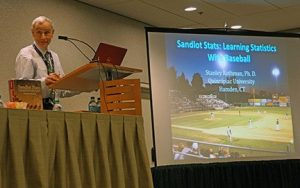This January I gave similar talks at both the Math Conference in Seattle Washington and at the Kiwanis Club of Naples on the Gulf. Both talks discussed my philosophy of teaching. That is, the teaching of any subject matter is more successful for the teacher and more enjoyable for the student if the student both understands the underlying content associated with the subject matter and also enjoys that content.


This philosophy led me to a different way of teaching the subject matter of statistics. In my course Baseball and Statistics, given each semester at Quinnipiac University, I teach an introductory course in statistics using the data from baseball. My students learn the same concepts as those students who take other introductory statistics classes such as in my biostatistics class. However, my feedback from the students in my baseball statistics class versus my biostatistics class is quite different. The difference is the students enjoy my baseball statistics class much more and seem to understand the concepts of statistics more. At the end of my baseball course students approach me and ask if they can do research with me. I am currently on sabbatical but two students from my fall baseball class will start researching with me next fall. One student is a male and the other is a female. In fact, each semester about 25% of the baseball class is made up of females.
The background which led to the establishment of my baseball and statistics course began in 2008 when Quinnipiac created a Sports Minor. I was then approached by the faculty director of the Sports Minor asking me to teach a course in sabermetrics, the science of using statistics to make objective decisions about baseball. Being a big baseball fan, A Yankee fan I might add, I loved the idea of combining two things I really enjoy baseball and statistics. However, I did not want to just teach sabermetrics but instead I wanted to teach a true introductory statistics course with baseball. In searching for a textbook I discovered that there were many sabermetrics books but no book to teach an introductory statistics course with baseball. Coincidentally, at the same time I was contacted by an editor for Johns Hopkins University Press about writing such a textbook. What led him to email me was he saw my course listed online. I agreed to do it and started my writing in 2008. The book “Sandlot Stats: Learning Statistics with Baseball” was published in 2012 by Johns Hopkins Press.
The first 15 chapters teach the concepts and the last three chapters apply these concepts to actual research problems. One chapter develops a formula for predicting batting streaks such as Joe DiMaggio’s 56-game hitting streak and another chapter tries to answer the question: Will a current player ever bat over .400 for a season? The last chapter uses 12 statistics to decide on the top ten hitters of all-time.
In my course, the students also read the book “Moneyball” so they can see how the statistics they are learning can be used in the real world. My book can be and is used both at high schools and at colleges to teach an introductory statistics course to those students who enjoy baseball. The book can also be used by any person who wants to learn statistics in a fun way. You can find the book online at Amazon or Barnes and Noble. Please go to my website www.sandlotstats.com to read the testimonials given by students and reviewers of my book. While there you can read my Interesting Facts about baseball. ,
